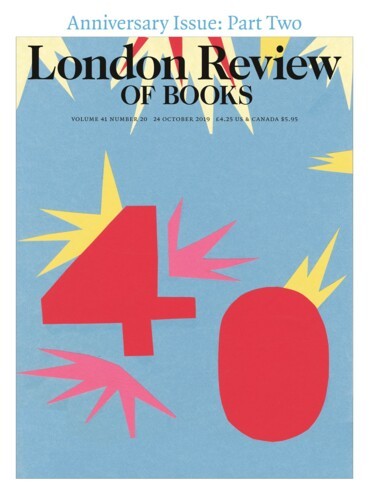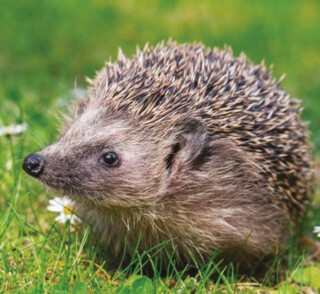Pliny the Elder was not an easy man. He reprimanded his nephew, Pliny the Younger, for walking instead of letting himself be carried, thereby wasting hours when he could have been reading. But in 77 ce Pliny made the hedgehog the focus of his attention, and produced one of the loveliest myths in natural history. ‘Hedgehogs,’ he wrote in his Historia Naturalis, ‘prepare food for the winter. They fix fallen apples on their spines by rolling on them and, with an extra one in their mouth, carry them to hollow trees.’ Saint Isidore of Seville picked up on the idea, insisting that hedgehogs collected grapes on their spines in order to carry them to their young. Charles Darwin wrote in 1867 that he had it on good authority that hedgehogs could be seen in the Spanish mountains ‘trotting along with at least a dozen of these strawberries sticking on their spines … carrying the fruit to their holes to eat in peace and security’.
Of all the wild untruths that I wish were fact, this one is high on my list. In fact, hedgehogs don’t eat fruit, preferring beetles, worms, eggs and small carrion. Nor do they hoard food for the winter, and nor have there been any recorded instances of their using their spines as cocktail sticks. But they are nonetheless remarkable; for their place in history, for their survival skills, and for their delicate, erudite beauty. Each hedgehog has around six thousand hollow spines, nut-brown at the base, rising to a strip of black and changing at the very tip to purest white. When threatened, they roll into an impenetrable ball, which deters almost all animals with the exception of badgers, and us: Pliny wrote that you could unroll them by sprinkling boiling water on their backs, which, unlike his dietary information, does seem to be true.
Aristotle suggested that hedgehogs mate upright on their hind legs, belly to belly, to avoid each other’s spines. In fact, they mate like other four-legged mammals, although the process is more stressful than for most: it’s not unusual for the female to move off, mid-mate, leaving the male struggling to keep up on two hind legs, slipping slowly down the rake of the female’s back. Hence the old joke: how do hedgehogs mate? With great and scrupulous care. When the hoglets arrive, after 35 days’ gestation, they are born reddish-pink, with a thin layer of skin over their spines; but the spikes start to break through immediately after birth. Within ten days they have learned how to roll into a ball; within 14, their eyes open, and they take on that distinctive look of polite, gracious inquisitiveness.
Although hedgehogs are ancient – they existed in nearly identical form 15 million years ago, back when we were still great apes – the name ‘hedgehog’ is a relatively recent invention. One of the earliest justifications of the name is in 1579, in Lyly’s Euphues: ‘Thou arte … not vnlyke vnto the hedgehogge, who euermore lodgeth in the thornes, because he himselfe is full of prickels.’ During the medieval period, though, they were ‘ilespil’ – from il meaning ‘hedgehog’, and pil meaning ‘prickle’: so, ‘hedgehog’ actually meant, tautologically, ‘hedgehog-prickle’ – or ‘urchins’. Prospero threatens Caliban in The Tempest: ‘Urchins shall, for that vast of night that they may work, all exercise on thee.’ The sea urchin, then, takes its name from the hedgehog.
Throughout history we have turned to the hedgehog: we have used them in our fables, and demanded that they cure us of our pains. In 1693 the physician William Salmon published a cure for baldness that involved mixing the fat of a hedgehog with that of a bear and applying it to the scalp. Failing that, he suggested optimistically that hedgehog dung might have a similar effect. He was not the first to have that thought: the Ebers Papyrus, dating from around 1550 bce, suggested that an amulet in the shape of a hedgehog would stop hair thinning. Its skin and spines have been thought to help with toothache, kidney stones, diarrhoea, vomiting, fever, deafness, cystitis, leprosy, elephantiasis and impotence. In Latvian folklore, the hedgehog is a symbol of regeneration and fertility; Latvian wedding songs dub the bride ‘she-hedgehog’, and married women ‘mothers of hedgehogs’.
We haven’t consumed them only as medicine. In Roma families the hedgehog might be encased in clay and roasted on a fire. Once cool, the clay would be broken open, taking all or most of the spines with it; the dish is known as hotchy-witchy. In 1393, the Ménagier de Paris suggested that the ‘hedgehog should have its throat cut, then be singed and gutted, then trussed like a pullet, then pressed in a towel until very dry; and then roasted and eaten with cameline sauce [a sauce of bread, wine, vinegar, cinnamon and ginger], or in pastry with wild duck sauce.’ I have a friend who has caught and eaten hedgehog: it tastes, she says, like anorexic rabbit.
Even today, when they are a protected species across most of the world, we have trouble leaving them alone. There are cafés in Tokyo where you can dress a hedgehog in a hat and handbag for a photograph. I went to see that once and although carefully treated by their handlers, the hedgehogs, clad in their felt bonnets, did not look as though they found the situation ideal.
In 2015 the MP Rory Stewart gave an impassioned 13-minute speech about hedgehogs to a largely empty House of Commons. It was the first time hedgehogs had been discussed by Parliament, he said, since 1566. (In fact, Stewart wasn’t quite right: in the 1650s, Sir Richard Onslow levelled an attack on Charles I’s foreign policy, saying he had ‘wrapped himself in his own bristles’ like a hedgehog – but that was only in passing.) The 1566 debate led to the decision to put a tuppence bounty on hedgehogs: farmers believed they suckled milk from cows in the night, and as a result as many as two million were hunted and handed in.
That was another of our mistakes: hedgehogs are lactose intolerant and milk can kill them. They’re a peculiar mix of tough and delicate: they are immune to most snake venom, but occasionally suffer from a condition known as ‘balloon syndrome’. A glottis that opens and closes at the top of the windpipe can become stuck, leaving the air with nowhere to go; the hedgehog inflates to more than twice its usual size, and has to be punctured like a balloon. But, as ever, we are their greatest enemy. Their numbers are falling catastrophically, and have been for decades. The loss of hedgerows, the increase in vast open fields without cover, and death by cars are to blame, alongside the mass use of pesticides and the reduction, thanks to global warming, of their insect prey. Despite pledges from 47,000 people in the UK to make their gardens more hedgehog-friendly (by leaving a small gap no larger than a CD in every fence to allow them to roam) there are currently only around a million left. That’s a 97 per cent drop from the 30 million that roamed the UK in the 1950s, and numbers are still falling. Around this time of year, there is the added risk of hedgehogs taking up residence in bonfires, and, come the fifth of November, being burned alive. If we were not used to hedgehogs – if they existed only in Yosemite or the Okavango Delta – we would surely travel thousands of miles to see them. The least we can do is refrain from setting alight some of the world’s sharpest and gentlest creatures.
Send Letters To:
The Editor
London Review of Books,
28 Little Russell Street
London, WC1A 2HN
letters@lrb.co.uk
Please include name, address, and a telephone number.


